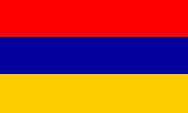Würzburg |
|
|
|
| Übersicht – Contents: | |
Würzburg |
|
|
|
| Übersicht – Contents: | |
| Flagge – Flag: | |
 |
1805–1806, Flagge Kurfürstentum Würzburg – flag Electorate of Würzburg, Quelle/Source, nach/by: World Statesmen |
 |
1806–1814, Flagge Großherzogtum Würzburg – flag Grand Duchy of Würzburg, Quelle/Source, nach/by: World Statesmen |
| Gelb und Rot sind die Farben der Stadt Würzburg, die auch von Bistum Würzburg verwendet wurden. Das Bistum wurde im Jahre 1803 zum Reichsdeputationshauptschluss aufgehoben und das Territorium zum größten Teil dem Kurfürstentum Bayern angeschlossen. Im Jahre 1805 (Frieden von Pressburg) trat Bayern Würzburg an Ferdinand von Habsburg ab, der den Kurfürstentitel hatte. Dafür erhielt Bayern zum Ausgleich Tirol. Im Jahre 1806 trat Würzburg dem Rheinbund bei, der Kurfürstentitel musste abgelegt werden, dafür wurde Würzburg zum Großherzogtum erhoben. Die Flagge wurde abgeändert, und zwischen dem roten und gelben Streifen ein blauer Streifen hinzugefügt. Die Farben sind eine Kombination der Farben des ehemaligen Bistums mit denen der Stadt Würzburg. | Yellow and red are the colors of the City of Würzburg, which were also used by the Diocese of Würzburg. The diocese was abolished in 1803 on the occasion of the German Mediatisation and its territory became mostly annexed to the Electorate of Bavaria. In 1805 (Treaty of Pressburg) Würzburg came from Bavaria to Ferdinand of Habsburg, who had the title of an Elector. Bavaria received Tyrolia for compensation. Würzburg joined in 1806 the Rhine Confederation, the Elector has to renounce its title, but in this way Würzburg became levied to a Grand Duchy. The flag has been changed and there was added a blue stripe between the red and the yellow stripe. The colours are a combination of the colors of the former diocese and the colours of the City of Würzburg. |
| Quelle/Source: Volker Preuß | |
| Wappen – Coat of Arms: | |
 |
Wappen Stadt Würzburg – coat of arms City of Würzburg |
 |
Wappen Bistum Würzburg – coat of arms Bishopric of Würzburg |
 |
Wappen Großherzogtum Würzburg – coat of arms Grand Duchy of Würzburg |
| Quelle/Source, nach/by: Wikipedia (D) | |
| Das Wappen der Stadt Würzburg zeigt ein sogenanntes "Rennfähnlein" in den Farben Rot und Gelb auf einem schwarzen Schild. Das Rennfähnlein erinnert an das Wappen des Bistums Würzburg, dort zeigt es jedoch die Farben Rot und Weiß, die Farben von Franken. Die Bischöfe von Würzburg waren seit dem 12. Jahrhundert nominell auch Herzöge von Franken. | The coat
of arms of the City of Würzburg shows a so-called "race flag" in the
colours red and yellow on a black shield. The race flag commemorates the coat of arms of the Diocese of Würzburg, but there are displayed the colors red and white, the colours of Franconia. The bishops of Würzburg were from the 12th century nominally also Dukes of Franconia. |
| Im Jahre 1805 (Frieden von Pressburg) trat Bayern Würzburg an Ferdinand von Habsburg ab, der den Titel eines Kurfürsten hatte, so entstand das Kurfürstentum Würzburg. Jetzt wurde der österreichische Bindenschild der Babenberger in die Mitte des Wappens des ehemaligen Bistums Würzburg aufgelegt, überhöht von einer Fürstenkrone. Als das Land 1806 Großherzogtum wurde, wurde das Wappen beibehalten. | In 1805
(Peace-Treaty of Pressburg) Bavaria ceded Würzburg to Ferdinand of
Habsburg, who had the title of an Elector. In this way was made the
Electorate of Würzburg. Now the Austrian tie shield was placed in the middle of the coat of arms of the former Diocese of Würzburg, surmounted by a crown of a Prince. When the country became a Grand Duchy in 1806, the coat of arms was retained. |
| Quelle/Source: Wikipedia (D), Volker Preuß | |
| Landkarte – Map: | |
|
|
| Die Landkarte zeigt das Großherzogtum Würzburg zwischen 1810 und 1813, in roter Umrandung. | The map shows the Grand Duchy of Würzburg between the years 1810 and 1813, within a red border. |
| Zahlen und Fakten – Numbers and Facts: | |
|
|
|
|
|
|
|
|
|
|
|
741 · Gründung des Bistums Würzburg 1168 · die Bischöfe von Würzburg werden zu Herzögen von Ostfranken ernannt 1792, 1796, 1800 und 1805 · Invasionen französischer Revolutionstruppen unter Napoléon in das Deutsche Reich, das Deutsche Reich unterliegt und wird von Napoléon territorial umgestaltet 1801 · alle linksrheinischen Gebiete werden an Frankreich abgetreten und von diesem einverleibt 1803 · Reichsdeputationshauptschluss, Umgestaltung der territorialen Gliederung des Deutschen Reiches, geistliche Besitzungen werden enteignet, alte Fürstenterritorien und freie Städte werden enteignet oder aufgehoben und alten oder neuen Fürstentümern übertragen, die Zahl der Gebietskörperschaften des Reiches wird dadurch von 300 auf 60 reduziert – das Bistum und Hochstift Würzburg wird abgeschafft, und sein Territorium größtenteils an das Kurfürstentum Bayern gegeben 26.12.1805· Frieden von Pressburg, Bayern erhält Tirol und tritt im Gegenzug Würzburg an Ferdinand Joseph aus dem Hause Habsburg (ehemaliger Großherzog der Toskana) ab, da dieser auf das Kurfürstentum Salzburg verzichtet, darf er den Kurfürstentitel behalten, und dieser wird auf Würzburg übertragen - es entsteht das Kurfürstentum Würzburg 12.07.1806 · Napoléon erzwingt die Gründung des Rheinbundes, ein Zusammenschluss von sechzehn süd- und südwestdeutschen Staaten unter französischem Protektorat 01.08.1806 · die Staaten des Rheinbunds treten aus dem Heiligen Römischen Reich Deutscher Nation aus 06.08.1806 · Kaiser Franz II. legt die Krone des Heiligen Römischen Reiches Deutscher Nation nieder, das Reich endet 26.09.1806· Ferdinand Joseph tritt dem Rheinbund bei, legt damit den Titel Kurfürst ab und wird zum Großherzog ernannt - es entsteht das Großherzogtum Würzburg Oktober 1813 · Niederlage Napoléons bei Leipzig, der Rheinbund beginnt sich aufzulösen 01.05.1814· Würzburg wird Bayern angeschlossen, das Großherzogtum endet 1815 · Wiener Kongress, Neuordnung Europas nach der Ära Napoléon, die Besitzverhältnisse und die Raumordnung im ehemaligen Deutschen Reich werden wieder hergestellt, jedoch nicht die Souveränität der geistlichen Länder, deren Besitzungen werden alten oder neuen Fürstentümern übertragen oder angeschlossen, Ferdinand Joseph, der ehemalige Großherzog von Würzburg, erhält die Toskana zurück, die 39 verbleibenden deutschen Staaten werden in einem lockeren Zusammenschluss, dem Deutschen Bund organisiert |
|
741 · founding of the Bishopric of Würzburg 1168 · the Bishops of Würzburg become appointed to Dukes of Eastern Franconia 1792, 1796, 1800 and 1805 · invasions of French revolutionary troops under Napoleon in the German Empire, the German Empire subjectes and becomes territorially transformed 1801 · all left-bank territories of the River Rhine ceded to France, and incorporated by this 1803 · German Mediatisation (Reichsdeputationshauptschluss), transformation of the territorial partition of the German Empire, ecclesiastical possessions become confiscated, old princely territories and free cities become confiscated or dissolved or annexed to old or new principalities, the number of sovereign authorities and territorial entities of the empire is thus reduced from 300 to 60 – the Diocese and Bishopric of Würzburg becomes abolished and its territory is given largely to the Electorate of Bavaria 26th of December in 1805 · Peace of Pressburg, Bavaria receives Tyrolia and cedes in return Würzburg to Ferdinand Joseph of Habsburg (former Grand Duke of Tuscany), even because he renounces the Electorate of Salzburg, he could keep the Elector title, and this becomes tranferred to Würzburg - rise of the Electorate of Würzburg 12th of July in 1806 · Napoleon forces the creation of the Rhine Confederation, an alliance of sixteen southern and southwestern German states under French protectorate 1st of August 1806 · the states of the Rhine Confederation declare themselves sovereign and resign from the Holy Roman Empire of German Nation 6th of August in 1806 · Emperor Franz II. lays down the crown of the Holy Roman Empire of German Nation, the empire ends 26th of September in 1806 · Ferdinand Joseph joins the Rhine Confederation, thereby he lays down the title of an Elector and becomes appointed ta a Grand Duke - rise of the Grand Duchy of Würzburg October 1813 · Napoleon's defeat at Leipzig, the Rhine Confederation starts to desintegrate 1st of May in 1814 · Würzburg becomes annexed to Bavaria, the Grand Duchy ends 1815 · Congress of Vienna, reconstruction of Europe after the era of Napoleon, the ownership and the administrative partitions in the former German Empire become restored, but not the sovereignty of the ecclesiastical countries, their possessions become transferred to old or new principalities, Joseph Ferdinand, the former Grand Duke of Würzburg gets the Tuscany back, the 39 remaining German states become organized in a loose association, the German Confederation |
| Quelle/Source: Wikipedia (D), World Statesmen |
| Der Name "Würzburg" geht auf eine Siedlung namens "Virteburg" am Fluss Main zurück. Das Wort "virt" oder "wirt" bedeutet "Schutzherr". | The name "Würzburg" comes from a settlement called "Virteburg" on the river Main. The word "virt" or "wirt" means "protector". |
| Quelle/Source: Handbuch der geographischen Namen | |